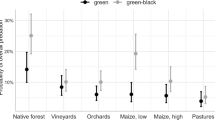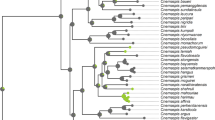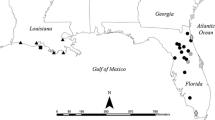Abstract
Most recorded extinctions have occurred on oceanic islands, mainly as a result of introduced mammalian predators. The impact of introduced non-mammalian competitors, however, is poorly understood. The house gecko, Hemidactylus frenatus, is one of the most successful invasive reptiles and has been implicated in the decline of endemic geckos and other taxa on a number of tropical and subtropical islands. We investigated the patterns of niche utilization between the house gecko and endemic ornate day gecko, Phelsuma ornata, in Mauritius, two species which were not believed to compete because they had different diel activity periods. The dietary and temporal niche partitioning of the two species were examined in relation to seasonal invertebrate prey abundance for three seasons. Dietary overlap between the two species was least when prey abundance was lowest and temporal overlap in activity greatest. Exploitative competition was therefore inferred, whereby changes in dietary overlap were attributed to shifts in prey selection by the day, but not the house, gecko, which was hypothesized to deplete prey. The compensatory response of the day gecko may have been to increase its tendency for cannibalism, such that the smaller house gecko was indirectly responsible for population reduction of its larger competitor. This is the first study to show how an invasive nocturnal gecko may be affecting a predominantly diurnal species.



Similar content being viewed by others
References
Arnold EN (1980) Recently extinct reptile populations from Mauritius and Réunion, Indian Ocean. J Zool 191:33–47
Autumn K, Jindrich D, DeNardo D, Mueller R (1999) Locomotor performance at low temperature and the evolution of nocturnality in geckos. Evolution 53:580–599
Bobrov VV (1992) Ecology of the common house gecko, Hemidactylus frenatus (Reptilia, Sauria, Gekkonidae) in Vietnam. Zool Zh 71:86–90
Bolger DT, Case TJ (1992) Intra- and interspecific interference behaviour among sexual and asexual geckos. Anim Behav 44:21–30
Bomford M, Kraus F, Barry SC, Lawrence E (2008) Predicting establishment success for alien reptiles and amphibians: a role for climate matching. Biol Invasions 11:713–724
Brown WL, Wilson EO (1956) Character displacement. Syst Zool 5:49–64
Brown SG, Lebrun R, Yamasaki J, Ishii-Thoene D (2002) Indirect competition between a resident unisexual and an invading bisexual gecko. Behaviour 139:1161–1173
Bullock DJ (1986) The ecology and conservation of reptiles on Round Island and Gunner’s Quoin, Mauritius. Biol Conserv 37:135–156
Case TJ, Bolger DT (1991) The role of introduced species in shaping the distribution and abundance of island reptiles. Evol Ecol 5:272–290
Case TJ, Bolger DT, Petren K (1994) Invasions and competitive displacement among house geckos in the tropical Pacific. Ecology 75:464–477
Cheke A, Hume J (2008) Lost land of the dodo: an ecological history of Mauritius. Réunion & Rodrigues, Poyser
Cole NC (2005) The ecological impact of the invasive house gecko Hemidactylus frenatus upon endemic Mauritian geckos. Dissertation, University of Bristol
Cole NC, Jones CG, Harris S (2005) The need for enemy-free space: the impact of an invasive gecko on island endemics. Biol Conserv 125:467–474
Colwell RK, Futuyma DJ (1971) On the measurement of niche breadth and overlap. Ecology 52:567–576
Connell JH (1983) On the prevalence and relative importance of interspecific competition: evidence from field experiments. Am Nat 122:661–696
Dame EA, Petren K (2006) Behavioural mechanisms of invasion and displacement in Pacific island geckos (Hemidactylus). Anim Behav 71:1165–1173
Dunham AE (1980) An experimental study of interspecific competition between the iguanid lizards Sceloporus merriami and Urosaurus ornatus. Ecol Monogr 50:309–330
Full RJ, Tullis A (1990) Capacity for sustained terrestrial locomotion in an insect: energetics, thermal-dependence, and kinematics. J Comp Physiol B 160:573–581
Hansen DM, Beer K, Müller C (2006) Mauritian coloured nectar no longer a mystery: a visual signal for lizard pollinators. Biol Lett 2:165–168
Huey RB, Pianka ER (1981) Ecological consequences of foraging mode. Ecology 62:991–999
Klawinski PD, Vaughan RK, Saenz D, Godwin W (1994) Comparison of dietary overlap between allopatric and sympatric geckos. J Herpetol 28:225–230
Kronfeld-Schor N, Dayan T (2003) Partitioning of time as an ecological resource. Annu Rev Ecol Evol Syst 34:153–181
Lechowicz MJ (1982) The sampling characteristics of electivity indices. Oecologia 52:22–30
Legler JM, Sullivan LJ (1979) Application of stomach-flushing to lizards and anurans. Herpetologica 35:107–110
Losos JB (2000) Ecological character displacement and the study of adaptation. Proc Natl Acad Sci USA 97:5693–5695
MacArthur RH, Levins R (1967) The limiting similarity, convergence, and divergence of coexisting species. Am Nat 101:377–385
Marcellini DL (1971) Activity patterns of the gecko Hemidactylus frenatus. Copeia 1971:631–635
McCoid MJ, Hensley RA (1993) Shifts in activity patterns in lizards. Herp Rev 24:87–88
Miranda JP, Andrade GV (2003) Seasonality in diet, perch use, and reproduction of the gecko Gonatodes humeralis from Eastern Brazilian Amazon. J Herpetol 37:433–438
Mooney HA, Cleland EE (2001) The evolutionary impact of invasive species. Proc Natl Acad Sci USA 98:5446–5451
Morin PJ (1999) Community ecology. Blackwell Science, Massachusetts
Nyhagen DF, Kragelund C, Olesen JM, Jones CG (2001) Insular interactions between lizards and flowers: flower visitation by an endemic Mauritian gecko. J Trop Ecol 17:755–761
Olesen JM, Eskildsen LI, Venkatasamy S (2002) Invasion of pollination networks on oceanic islands: importance of invader complexes and endemic super generalists. Divers Distrib 8:181–192
Petren K, Case TJ (1996) An experimental demonstration of exploitation competition in an ongoing invasion. Ecology 77:118–132
Petren K, Case TJ (1998) Habitat structure determines competitive intensity and invasion success in gecko lizards. Proc Natl Acad Sci USA 95:11739–11744
Pianka ER (1969) Habitat specificity, speciation, and species density in Australian desert lizards. Ecology 50:498–502
Pianka ER (1973) The structure of lizard communities. Annu Rev Ecol Syst 4:53–74
Pianka ER, Huey RB (1978) Comparative ecology, resource utilization and niche segregation among gekkonid lizards in the southern Kalahari. Copeia 1978:691–701
Pianka ER, Pianka HD (1976) Comparative ecology of twelve species of nocturnal lizards (Gekkonidae) in the Western Australian desert. Copeia 1976:125–142
Polis GA, Myers CA, Holt RD (1989) The ecology and evolution of intraguild predation: potential competitors that eat each other. Annu Rev Ecol Syst 20:297–330
Poulin B, Lefebvre G, Rand AS (1995) Hemidactylus frenatus (house gecko). Foraging. Herp Rev 26:205
Powell R, Parmerlee JS, Rice MA (1990) Ecological observations of Hemidactylus brooki haitianus Meerwarth (Sauria: Gekkonidae) from Hispaniola. Caribb J Sci 26:67–70
Saenz D (1996) Dietary overview of Hemidactylus turcicus with possible implications of food partitioning. J Herpetol 30:461–466
Schoener TW (1974) Resource partitioning in ecological communities. Science 185:27–39
Schoener TW (1983) Field experiments on interspecific competition. Am Nat 122:240–285
Schoener TW (1985) Some comments on Connell’s and my reviews of field experiments on interspecific competition. Am Nat 125:730–740
Smith DC (1981) Competitive interactions of the striped plateau lizard (Sceloporus virgatus) and the tree lizard (Urosaurus ornatus). Ecology 62:679–687
Vanderploeg HA, Scavia D (1979) Calculation and use of selectivity coefficients of feeding: zooplankton grazing. Ecol Model 7:135–149
Vinson J-M (1975) Notes on the reptiles of Round Island. Maurit Inst Bull 8:49–67
Vinson J, Vinson J-M (1969) The saurian fauna of the Mascarene Islands. Maurit Inst Bull 6:203–320
Vitousek PM, Loope LL, Stone CP (1987) Introduced species in Hawaii: biological effects and opportunities for ecological research. Trends Ecol Evol 2:224–227
Vitt LJ, Zani PA (1998) Prey use among sympatric lizard species in lowland rain forest of Nicaragua. J Trop Ecol 14:537–559
Williamson M (1996) Biological invasions. Chapman and Hall, London
Zuël N (2009) Ecology and conservation of an endangered reptile community on Round Island, Mauritius. Dissertation, Universität Zürich
Acknowledgments
We thank the Mauritian Wildlife Foundation, particularly Asha Poonyth and Poonam Gangaram for phenology data, and the National Parks and Conservation Service, Ministry of Ago-Industry, Mauritius for supporting this study, Lisa Cole for assistance in the field, and Phil Baker and two anonymous reviewers for constructive comments that improved the manuscript. The Natural Environment Research Council (NC), Durrell Wildlife Conservation Trust (NC), and Dulverton Trust (SH) funded this research, which was approved by the University of Bristol’s ethical review committee (UB/03/063).
Author information
Authors and Affiliations
Corresponding author
Rights and permissions
About this article
Cite this article
Cole, N.C., Harris, S. Environmentally-induced shifts in behavior intensify indirect competition by an invasive gecko in Mauritius. Biol Invasions 13, 2063–2075 (2011). https://doi.org/10.1007/s10530-011-0025-8
Received:
Accepted:
Published:
Issue Date:
DOI: https://doi.org/10.1007/s10530-011-0025-8




